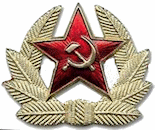1960-1970 - Revolution in Military Affairs
 In 1960 Soviet Premier N. S. Khrushchev's open declaration that a revolution had taken place in military affairs signified a major shift in Soviet military doctrine. Marshal of the Soviet Union Vassily D. Sokolovsky's 1962 work Voyennaya strategiya (Military Strategy) summed up the nature of the change: "The fires of nuclear weapons will play a decisive role on the battlefield; the other means of armed conflict will utilize the nuclear attack for the final defeat of the enemy."
In 1960 Soviet Premier N. S. Khrushchev's open declaration that a revolution had taken place in military affairs signified a major shift in Soviet military doctrine. Marshal of the Soviet Union Vassily D. Sokolovsky's 1962 work Voyennaya strategiya (Military Strategy) summed up the nature of the change: "The fires of nuclear weapons will play a decisive role on the battlefield; the other means of armed conflict will utilize the nuclear attack for the final defeat of the enemy."
Soviet acceptance of the notion that future war would inevitably be nuclear had serious implications for traditional Soviet views concerning the nature and conduct of military operations and for the Soviet force structure. The strategic nuclear exchange became all-important, and the newly formed strategic rocket forces replaced the ground forces as the premier arm of the armed forces. Strategic considerations eclipsed the realm of operational art, and operational maneuver ceased to be an area of fundamental concern.
Reflecting this doctrinal change, the Soviet ground force structure shrank to roughly 140 divisions, each better tailored to operate in a nuclear environment. Tank and combined-arms armies decreased in manpower and weaponry, and tank armies and divisions became armor-pure entities more capable of surviving on a nuclear battlefield. Ground forces would perform the simple mission of cleaning up the battlefield after the nuclear exchange.
Given the more restrictive role of the ground forces, Soviet fronts and armies would normally deploy in two-echelon configuration across larger frontages and disperse to greater depths. At every level armor forces would operate in the first echelon, because of their reduced vulnerability to the effects of nuclear weapons, and advance along numerous axes to exploit gaps created by nuclear fires. Operational maneuver was irrelevant in these chaotic scenarios, since nuclear forces would be the principal means for destroying the enemy. Consequently, Soviet commanders did not employ operational maneuver forces as specific functional entities. However, tactical maneuver became far more important on this fragmented and potentially contaminated battlefield. Numerous, tank-heavy forward detachments spearheaded ground operations, protected from the adverse effects of the nuclear environment by their small size, greater speed, and heavier armored protection. This offensive scheme also revived the utility and prestige of airborne forces, since they were particularly well suited to cooperate with tactical maneuver forces.
|
NEWSLETTER
|
| Join the GlobalSecurity.org mailing list |
|
|
|

